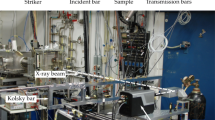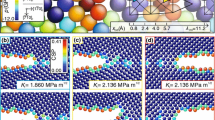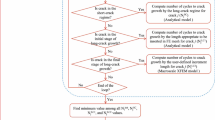Abstract
Brittle and quasibrittle materials such as ceramics and geomaterials fail through dynamic crack propagation during impact events. Simulations of such events are important in a number of applications. This paper compares the effectiveness of the embedded finite element method (EFEM) and the extended finite element method (XFEM) in modeling dynamic crack propagation by validating each approach against an impact experiment performed on single crystal quartz together with in-situ imaging of the dynamic fracture using X-ray phase contrast imaging (XPCI). The experiment is conducted in a Kolsky bar (generating a strain rate on the order of \(10^3\,\text {s}^{-1}\)) that is operated at the synchrotron facilities at the advanced photon source (APS). The in situ XPCI technique can record the dynamic crack propagation with micron-scale spatial resolution and sub-microsecond temporal resolution, and the corresponding images are used to extract the time-resolved crack propagation path and velocity. A unified framework is first presented for the dynamic discretization formulations of EFEM and XFEM. This framework clarifies the differences between the two methods in enrichment techniques and numerical solution schemes. In both cases, a cohesive law is used to describe the fracture process after crack initiation. The simulations of the dynamic fracture experiment using the two simulation approaches are compared with the in situ experimental observations and measurements. The performance of each method is discussed with respect to capturing the early crack propagation process.














Similar content being viewed by others
References
Abedi R, Haber RB, Clarke PL (2017) Effect of random defects on dynamic fracture in quasi-brittle materials. Int J Fract 208(1):241–268. https://doi.org/10.1007/s10704-017-0243-x
Areias P, Belytschko T (2005) Non-linear analysis of shells with arbitrary evolving cracks using XFEM. Int J Numer Methods Eng 62(3):384–415
Armero F, Garikipati K (1996) An analysis of strong discontinuities in multiplicative finite strain plasticity and their relation with the numerical simulation of strain localization in solids. Int J Solids Struct 33(20):2863–2885. https://doi.org/10.1016/0020-7683(95)00257-X. http://www.sciencedirect.com/science/article/pii/002076839500257X
Armero F, Linder C (2009) Numerical simulation of dynamic fracture using finite elements with embedded discontinuities. Int J Fract 160(2):119–141
Bažant ZP (2002) Concrete fracture models: testing and practice. Eng Fract Mech 69(2):165–205. https://doi.org/10.1016/S0013-7944(01)00084-4. http://www.sciencedirect.com/science/article/pii/S0013794401000844
Bechmann R (1958) Elastic and piezoelectric constants of alpha-quartz. Phys Rev 110:1060–1061. https://doi.org/10.1103/PhysRev.110.1060
Belytschko T, Black T (1999) Elastic crack growth in finite elements with minimal remeshing. Int J Numer Methods Eng 45(5):601–620
Belytschko T, Chen H, Xu J, Zi G (2003) Dynamic crack propagation based on loss of hyperbolicity and a new discontinuous enrichment. Int J Numer Methods Eng 58(12):1873–1905
Belytschko T, Liu WK, Moran B, Elkhodary K (2013) Nonlinear finite elements for continua and structures. Wiley, London
Benedetti I, Aliabadi M (2013) A three-dimensional cohesive–frictional grain-boundary micromechanical model for intergranular degradation and failure in polycrystalline materials. Comput Methods Appl Mech Eng 265:36–62. https://doi.org/10.1016/j.cma.2013.05.023. http://www.sciencedirect.com/science/article/pii/S0045782513001503
Borja RI (2000) A finite element model for strain localization analysis of strongly discontinuous fields based on standard Galerkin approximation. Comput Methods Appl Mech Eng 190(11):1529–1549. https://doi.org/10.1016/S0045-7825(00)00176-6. http://www.sciencedirect.com/science/article/pii/S0045782500001766
Borja RI (2008) Assumed enhanced strain and the extended finite element methods: a unification of concepts. Comput Methods Appl Mech Eng 197(33–40):2789–2803. https://doi.org/10.1016/j.cma.2008.01.019. http://www.sciencedirect.com/science/article/pii/S0045782508000315
Camacho G, Ortiz M (1996) Computational modelling of impact damage in brittle materials. Int J Solids Struct 33(20–22):2899–2938. https://doi.org/10.1016/0020-7683(95)00255-3. http://www.sciencedirect.com/science/article/pii/0020768395002553
Carol I, Prat P, López C (1997) Normal/shear cracking model: application to discrete crack analysis. J Eng Mech 123(8):765–773. https://doi.org/10.1061/(ASCE)0733-9399(1997) 123:8(765)
de Borst R, Remmers JJ, Needleman A (2006) Mesh-independent discrete numerical representations of cohesive-zone models. Eng Fract Mech 73(2):160–177. https://doi.org/10.1016/j.engfracmech.2005.05.007. http://www.sciencedirect.com/science/article/pii/S0013794405001852
Dias-da Costa D, Alfaiate J, Sluys LJ, Júlio E (2009) A comparative study on the modelling of discontinuous fracture by means of enriched nodal and element techniques and interface elements. Int J Fract 161(1):97. https://doi.org/10.1007/s10704-009-9432-6
Dolbow J, Moës N, Belytschko T (2001) An extended finite element method for modeling crack growth with frictional contact. Comput Methods Appl Mech Eng 190(51):6825–6846
Espinosa HD, Zavattieri PD (2003) A grain level model for the study of failure initiation and evolution in polycrystalline brittle materials. Part I: Theory and numerical implementation. Mech Mater 35(3–6):333–364. https://doi.org/10.1016/S0167-6636(02)00285-5
Fineberg J, Gross SP, Marder M, Swinney HL (1991) Instability in dynamic fracture. Phys Rev Lett 67(4):457
Follansbee P, Frantz C (1983) Wave propagation in the split Hopkinson pressure bar. J Eng Mater Technol 105(1):61–66
Gálvez J, Cervenka J, Cendon D, Saouma V (2002) A discrete crack approach to normal/shear cracking of concrete. Cem Concr Res 32(10):1567–1585. https://doi.org/10.1016/S0008-8846(02)00825-6. http://www.sciencedirect.com/science/article/pii/S0008884602008256
Hansbo A, Hansbo P (2004) A finite element method for the simulation of strong and weak discontinuities in solid mechanics. Comput Methods Appl Mech Eng 193(33):3523–3540. https://doi.org/10.1016/j.cma.2003.12.041. http://www.sciencedirect.com/science/article/pii/S0045782504000507
Huespe A, Oliver J, Sanchez P, Blanco S, Sonzogni V (2006) Strong discontinuity approach in dynamic fracture simulations. Mecán Comput 25:1997–2018
Hughes TJR (1987) The finite element method: linear static and dynamic finite element analysis. Prentice-Hall, Englewood Cliffs
Ida Y (1972) Cohesive force across the tip of a longitudinal-shear crack and Griffith’s specific surface energy. J Geophys Res 77(20):3796–3805. https://doi.org/10.1029/JB077i020p03796
IEEE (1988) IEEE standard on piezoelectricity. ANSI/IEEE Std 176-1987. https://doi.org/10.1109/IEEESTD.1988.79638
Iwasa M, Bradt R (1987) Cleavage of natural and synthetic single crystal quartz. Mater Res Bull 22(9):1241–1248. https://doi.org/10.1016/0025-5408(87)90134-6. http://www.sciencedirect.com/science/article/pii/0025540887901346
Iwasa M, Ueno T, Bradt RC (1981) Fracture toughness of quartz and sapphire single crystals at room temperature. J Soc Mater Sci Jpn 30(337):1001–1004. https://doi.org/10.2472/jsms.30.1001
Jirásek M (2000) Comparative study on finite elements with embedded discontinuities. Comput Methods Appl Mech Eng 188(1):307–330. https://doi.org/10.1016/S0045-7825(99)00154-1. http://www.sciencedirect.com/science/article/pii/S0045782599001541
Kalthoff J, Winkler S (1988) Failure mode transition at high rates of shear loading. Int Conf Impact Load Dyn Behav Mater 1:185–195
Leon S, Spring D, Paulino G (2014) Reduction in mesh bias for dynamic fracture using adaptive splitting of polygonal finite elements. Int J Numer Methods Eng 100(8):555–576
Leong AFT, Robinson AK, Fezzaa K, Sun T, Sinclair N, Casem DT, Lambert PK, Hustedt CJ, Daphalapurkar NP, Ramesh KT, Hufnagel TC (2018) Quantitative in situ studies of dynamic fracture in brittle solids using dynamic X-ray phase contrast imaging. Exp Mech https://doi.org/10.1007/s11340-018-0414-3
Melenk J, Babus̆ka I, (1996) The partition of unity finite element method: basic theory and applications. Comput Methods Appl Mech Eng 139(1):289–314. https://doi.org/10.1016/S0045-7825(96)01087-0. http://www.sciencedirect.com/science/article/pii/S0045782596010870
Menouillard T, Réthoré J, Combescure A, Bung H (2006) Efficient explicit time stepping for the extended finite element method (X-FEM). Int J Numer Methods Eng 68(9):911–939
Moës N, Dolbow J, Belytschko T (1999) A finite element method for crack growth without remeshing. Int J Numer Methods Eng 46(1):131–150. 10.1002/(SICI)1097-0207(19990910)46:1\(<\)131::AID-NME726\(>\)3.0.CO;2-J
Motamedi M, Weed D, Foster C (2016) Numerical simulation of mixed mode (I and II) fracture behavior of pre-cracked rock using the strong discontinuity approach. Int J Solids Struct 85–86:44–56. https://doi.org/10.1016/j.ijsolstr.2016.02.002. http://www.sciencedirect.com/science/article/pii/S0020768316000494
Oliver J (1996) Modelling strong discontinuities in solid mechanics via strain softening constitutive equations. Part 1: fundamentals. Int J Numer Methods Eng 39(21):3575–3600. 10.1002/(SICI)1097-0207(19961115)39:21\(<\)3575:: AID-NME65\(>\)3.0.CO;2-E
Oliver J, Huespe A, Pulido M, Chaves E (2002) From continuum mechanics to fracture mechanics: the strong discontinuity approach. Eng Fract Mech 69(2):113–136. https://doi.org/10.1016/S0013-7944(01)00060-1. http://HrBwww.sciencedirect.com/science/article/pii/S00137944010HrB00601
Oliver J, Huespe A, Sánchez P (2006) A comparative study on finite elements for capturing strong discontinuities: E-FEM vs. X-FEM. Comput Methods Appl Mech Eng 195(37–40):4732–4752. https://doi.org/10.1016/j.cma.2005.09.020. http://www.sciencedirect.com/science/article/pii/S0045782505005049
Ortiz M, Pandolfi A (1999) Finite-deformation irreversible cohesive elements for three-dimensional crack-propagation analysis. Int J Numer Methods Eng 44(9):1267–1282. 10.1002/(SICI)1097-0207(19990330)44:9\(<\)1267::AID-NME486\(>\)3.0.CO;2-7
Rabczuk T (2013) Computational methods for fracture in brittle and quasi-brittle solids: state-of-the-art review and future perspectives. ISRN Appl Math 2013:38
Ramulu M, Kobayashi AS (1985) Mechanics of crack curving and branching—a dynamic fracture analysis. Int J Fract 27(3):187–201. https://doi.org/10.1007/BF00017967
Rangarajan R, Chiaramonte MM, Hunsweck MJ, Shen Y, Lew AJ (2015) Simulating curvilinear crack propagation in two dimensions with universal meshes. Int J Numer Methods Eng 102(3–4):632–670
Rinehart AJ, Bishop JE, Dewers T (2015) Fracture propagation in Indiana limestone interpreted via linear softening cohesive fracture model. J Geophys Res Solid Earth 120(4):2292–2308. https://doi.org/10.1002/2014JB011624. https://agupubs.onlinelibrary.wiley.com/doi/pdf/10.1002/2014JB011624
Saksala T, Brancherie D, Harari I, Ibrahimbegovic A (2015) Combined continuum damage-embedded discontinuity model for explicit dynamic fracture analyses of quasi-brittle materials. Int J Numer Methods Eng 101(3):230–250
Sancho JM, Planas J, Galves JC, Reyes E, Cendon DA (2006) An embedded cohesive crack model for finite element analysis of mixed mode fracture of concrete*. Fatigue Fract Eng Mater Struct 29(12):1056–1065. https://doi.org/10.1111/j.1460-2695.2006.01076.x
Scheider I, Brocks W (2003) Simulation of cup-cone fracture using the cohesive model. Eng Fract Mech 70(14):1943–1961. https://doi.org/10.1016/S0013-7944(03)00133-4. http://www.sciencedirect.com/science/article/pii/S00137HrB94403001334HrB
Sharon E, Fineberg J (1996) Microbranching instability and the dynamic fracture of brittle materials. Phys Rev B 54:7128–7139. https://doi.org/10.1103/PhysRevB.54.7128
Simo JC, Rifai MS (1990) A class of mixed assumed strain methods and the method of incompatible modes. Int J Numer Methods Eng 29(8):1595–1638. https://doi.org/10.1002/nme.1620290802
Simo JC, Oliver J, Armero F (1993) An analysis of strong discontinuities induced by strain-softening in rate-independent inelastic solids. Comput Mech 12(5):277–296. https://doi.org/10.1007/BF00372173
Simulia (2014) Abaqus analysis user’s guide, version 6.14. Simulia
Song JH, Belytschko T (2009) Dynamic fracture of shells subjected to impulsive loads. J Appl Mech 76(5):051301
Song JH, Areias P, Belytschko T (2006) A method for dynamic crack and shear band propagation with phantom nodes. Int J Numer Methods Eng 67(6):868–893
Song JH, Wang H, Belytschko T (2008) A comparative study on finite element methods for dynamic fracture. Comput Mech 42(2):239–250. https://doi.org/10.1007/s00466-007-0210-x
Sukumar N, Chopp D, Moës N, Belytschko T (2001) Modeling holes and inclusions by level sets in the extended finite-element method. Comput Methods Appl Mech Eng 190(46):6183–6200. https://doi.org/10.1016/S0045-7825(01)00215-8. http://www.sciencedirect.com/science/article/pii/S0045782501002158
Ward RW (1984) The constants of alpha quartz. In: 38th annual symposium on frequency control, pp 22–31. https://doi.org/10.1109/FREQ.1984.200732
Weed DA, Foster CD, Motamedi MH (2017) A robust numerical framework for simulating localized failure and fracture propagation in frictional materials. Acta Geotech 12(2):253–275. https://doi.org/10.1007/s11440-016-0474-4
Wells G, Sluys L (2000) Application of embedded discontinuities for softening solids. Eng Fract Mech 65(2–3):263–281. https://doi.org/10.1016/S0013-7944(99)00120-4. http://HrBwww.sciencedirect.com/science/article/pii/S00137944990HrB01204
Wells GN, Sluys L (2001) A new method for modelling cohesive cracks using finite elements. Int J Numer Methods Eng 50(12):2667–2682
Xu D, Liu Z, Liu X, Zeng Q, Zhuang Z (2014) Modeling of dynamic crack branching by enhanced extended finite element method. Comput Mech 54(2):489–502
Yoffe EH (1951) The moving Griffith crack. Lond Edinb Dublin Philos Mag J Sci 42(330):739–750. https://doi.org/10.1080/14786445108561302
Zeng Q, Liu Z, Wang T, Gao Y, Zhuang Z (2018) Fully coupled simulation of multiple hydraulic fractures to propagate simultaneously from a perforated horizontal wellbore. Comput Mech 61(1):137–155. https://doi.org/10.1007/s00466-017-1412-5
Zhang ZJ, Paulino GH, Celes W (2007) Extrinsic cohesive modelling of dynamic fracture and microbranching instability in brittle materials. Int J Numer Methods Eng 72(8):893–923. https://doi.org/10.1002/nme.2030
Zhou F, Molinari JF, Ramesh KT (2006) Effects of material properties on the fragmentation of brittle materials. Int J Fract 139(2):169–196. https://doi.org/10.1007/s10704-006-7135-9
Acknowledgements
This work was supported by the Defense Threat Reduction Agency, Basic Research Award # HDTRA1-15-1-0056, to Johns Hopkins University. The content, views, and conclusions contained in this document are those of the authors and should not be interpreted as representing the official positions or policies, either expressed or implied, of the Defense Threat Reduction Agency or the US Government. The US Government is authorized to reproduce and distribute reprints for government purposes notwithstanding any copyright notation herein.
Author information
Authors and Affiliations
Corresponding author
Additional information
Publisher's Note
Springer Nature remains neutral with regard to jurisdictional claims in published maps and institutional affiliations.
Rights and permissions
About this article
Cite this article
Zeng, Q., Motamedi, M.H., Leong, A.F.T. et al. Validated simulations of dynamic crack propagation in single crystals using EFEM and XFEM. Int J Fract 215, 49–65 (2019). https://doi.org/10.1007/s10704-018-0330-7
Received:
Accepted:
Published:
Issue Date:
DOI: https://doi.org/10.1007/s10704-018-0330-7




